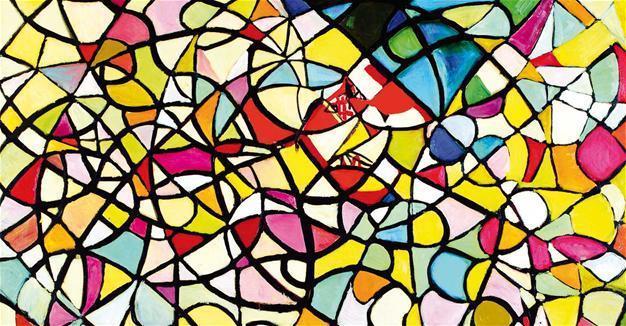Fahrelnissa Zeid at Istanbul Modern
ISTANBUL

Istanbul Modern is presenting a selection from its comprehensive collection of works by Fahrelnissa Zeid, a pioneer of modern art in Turkey and one of the first exponents of abstract art. The exhibition will be on view until July 30.
Eleven years after “Two Generations of the Rainbow,” the retrospective of Zeid together with her son Nejad Melih Devrim, Istanbul Modern is revisiting its collection of Zeid’s works for a special selection in its Pop-Up Exhibition Area.
The exhibition features 23 artworks, not only abstract geometric compositions in which the artist excelled, but also expressionist paintings that merge her unique color palette with references to Byzantine, Islamic and Western art.
The selection focuses on Zeid’s most prolific years between the 1940s, which marks her introduction to the art scene in Turkey, and the 1970s, when she moved to Amman, Jordan.
The global art world’s revived interest in Zeid has led to a flurry of her works in 2017, including group shows in Haus der Kunst in Munich and GAM di Torino. This year, eight works from the Istanbul Museum of Modern Art Collection that are among the most important in Zeid’s career will be on view in London, Berlin and Beirut, starting with her retrospective at Tate Modern as of June 13.
Oya Eczacıbaşı, board chair of Istanbul Modern, spoke about the special significance of Zeid to Istanbul Modern as well as in Turkey’s modern art.
“When Istanbul Modern was still just an idea, the family of Turkey’s world-renowned artist Fahrelnissa Zeid made a gift of her masterpiece ‘My Hell’ to the museum we dreamed of opening one day. The moment Istanbul Modern was founded, the first work to enter the museum was this one. With Zeid’s increased visibility in the global art world, we wanted to bring the artist’s works together again after 11 years and introduce them to new generations,” she said.
‘Zeid’s position secured’
Istanbul Modern director Levent Çalıkoğlu said 2017 is the year of Zeid in the global art world.
“Without a doubt Zeid’s life story, character and approach to art make her one of the most creative artists of her generation and epoch. The belated interest of Western museums and art community in Zeid’s person and works, which is clearly evident in this year’s international exhibition calendar, is restoring her the value she deserves. In particular, the retrospective that Tate Modern is organizing will secure Zeid’s position in the global art world. Since we have a comprehensive collection of Zeid’s work, we are also supporting this global interest with this selection,” he said.
In conjunction with the exhibition, the Istanbul Modern Education and Social Projects Department designed education programs and workshops for children and young people.
The extensively researched documentary coproduced by Istanbul Modern and CNN Turk for the 2006 exhibition “Fahrelnissa & Nejad: Two Generations of the Rainbow” will be on view once again in the exhibition space.
About Fahrelnissa Zeid Zeid was born in Büyükada in the Ottoman Empire in 1901 as the niece of Grand Vizier Cevat Paşa. She came from a large family of artists that included author Cevat Şakir Kabaağaçlı and painter Aliye Berger, her siblings. Her children from her marriage with author İzzet Melih Devrim were the painter Nejad Melih Devrim and the director and theater actress Şirin Devrim. Zeid was also the aunt of ceramic artist Füreya Koral.
Being one of the first female graduates of the Sanayi-i Nefise (Academy of Fine Arts), Zeid continued her studies in painting in the studio of Stalbach at the Académie Ranson in Paris, and later in the studio of Namık İsmail in Istanbul. In 1934, she married Prince Zeid, Iraqi ambassador to Ankara, becoming a princess. In 1942, she joined Group D and took part in their exhibitions.
After her first solo exhibition held in her home in Maçka in 1944, Zeid had her works exhibited in Paris, London, New York, Brussels and other cities where the couple lived after World War II. In 1976, Zeid moved permanently to Amman, where she established an institute of arts bearing her name and which she supported throughout her remaining years while continuing to produce art. She died in 1991 in Amman.
Known for her exuberant, powerful compositions, Zeid has a unique visual language so vivid and rich that it cannot be reduced to a single style. Her artistic practice can be classified under the following periods: an early period of figurative compositions with spaces constructed according to the style of miniatures; a period of maturity with geometrical and freely abstractionist works reminiscent of stained glass surfaces; and a late period consisting mainly of portraits in which psychological narrative comes to the fore.
 Istanbul Modern is presenting a selection from its comprehensive collection of works by Fahrelnissa Zeid, a pioneer of modern art in Turkey and one of the first exponents of abstract art. The exhibition will be on view until July 30.
Istanbul Modern is presenting a selection from its comprehensive collection of works by Fahrelnissa Zeid, a pioneer of modern art in Turkey and one of the first exponents of abstract art. The exhibition will be on view until July 30.